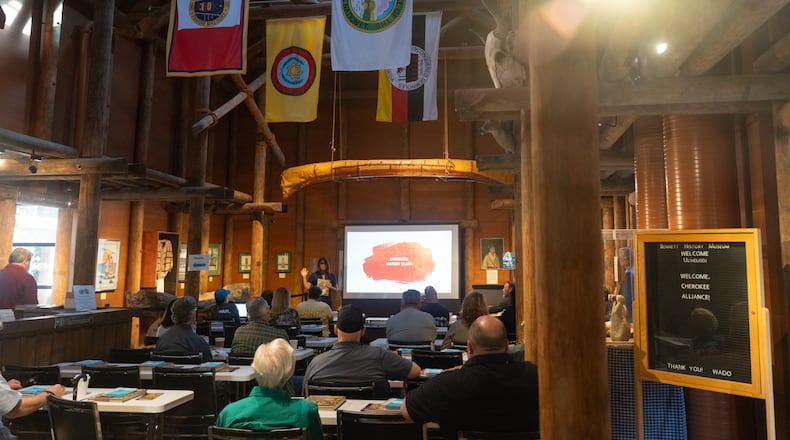WALESKA — Lavonna Pettit joined a gathering here on Reinhardt University’s campus this weekend to learn about her people, a small but historically important part of Georgia’s population. A Dalton resident, Pettit is among about 2,400 Cherokee Nation citizens living in the state.
The two-day event she attended at the university’s Funk Heritage Center was led by historians from the Cherokee Nation and Oklahoma Historical Society. And it featured lessons about Cherokee history, language and culture.
Pettit was particularly interested to learn more about the leadership roles women played in the Cherokees’ matrilineal communities.
“I am on a journey of reconnecting with my culture,” said Pettit, who grew up in Sequoyah County, Oklahoma, and resided in North Carolina before moving to Georgia this year.
During the summer, Cherokee lived in longhouses made of mud, clay, brush and rivercane, according to Catherine Foreman Gray, a Cherokee historian who served as one of the event’s featured speakers. To settle disputes between them, she said, Cherokee played a stickball game they sometimes called “Little Brother of War.” Modern-day lacrosse bears similarities.
David Fowler, a regional director of the Oklahoma Historical Society, led the history lessons with Gray, discussing Cherokee farming techniques and the different types of corn he raises today.
Members of the audience were each given a copy of “Cherokee Nation: A History of Survival, Self Determination & Identity” by Bob Blackburn, Duane King and Neil Morton. Published by the Cherokee Nation, it highlights how Georgia passed laws oppressing the Cherokee.
Credit: Ben Hendren
Credit: Ben Hendren
Between 1827 and 1831, according to the New Georgia Encyclopedia, the state’s Legislature extended Georgia’s jurisdiction over Cherokee territory, setting in motion a process of seizing Cherokee land and offering it to white Georgians as part of a lottery. Demand for Cherokee territory rose after gold was discovered on it in 1829.
The following year, President Andrew Jackson signed into law the Indian Removal Act of 1830. When the Cherokee were uprooted, rapacious thieves targeted their property. Many Cherokee were put in stockades before they were forced to migrate west to Oklahoma on the Trail of Tears. Thousands died on the way.
Reinhardt researchers are transcribing claims Cherokee filed in the 19th century to recoup property they allege was stolen from them or that they were forced to abandon as state and federal authorities expelled them from their homes.
Today, more than 466,000 Cherokee citizens live across the United States, according to the Cherokee Nation. There are some in all 50 states. The largest share — 283,227 — call Oklahoma home.
Each person applying for Cherokee citizenship must show a direct connection to an ancestor on the Dawes Rolls. Those federal documents are lists of more than 101,000 people who were accepted as eligible for tribal membership with the Cherokee, Creeks, Choctaws, Chickasaws and Seminoles, primarily from 1899-1906, according to the U.S. National Archives.
This weekend’s event at Reinhardt was timely because of impostors, said Cherokee Nation Principal Chief Chuck Hoskin Jr. The Cherokee, Hoskin said, “are probably the most, I would say, fraudulently copied people in North America.”
“We are combating a lot of false history, false narratives,” he said, adding Georgia “is unfortunately home to a lot of folks who claim to be Cherokee in an organized way and in a deceptive way. And they are simply not.”
Stephen Mathis of Dahlonega leads the Georgia Cherokee Community Alliance, which supported the gathering at Reinhardt. Mathis, who grew up in Texas, has traced his Cherokee ancestry to the Murphy, North Carolina, area and Rogers County, Oklahoma. Such history lessons, Mathis said, help with “connecting our people back together.”
Credit: Ben Hendren
Credit: Ben Hendren
About the Author
Keep Reading
The Latest
Featured




